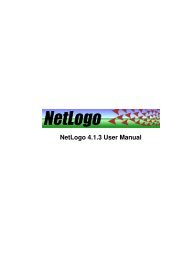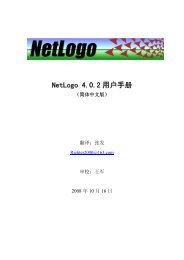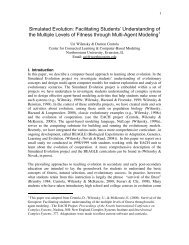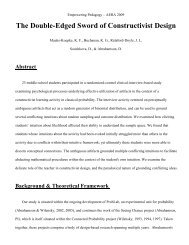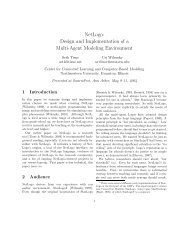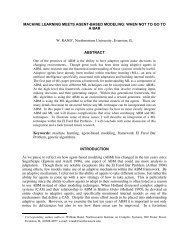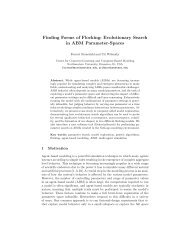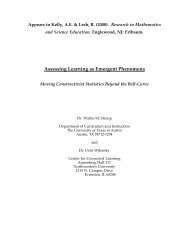Design Guidelines for Agent Based Model Visualization
Design Guidelines for Agent Based Model Visualization
Design Guidelines for Agent Based Model Visualization
You also want an ePaper? Increase the reach of your titles
YUMPU automatically turns print PDFs into web optimized ePapers that Google loves.
<strong>Design</strong> <strong>Guidelines</strong> <strong>for</strong> <strong>Agent</strong> <strong>Based</strong> <strong>Model</strong> <strong>Visualization</strong><br />
10.10<br />
11.1<br />
11.2<br />
11.3<br />
11.4<br />
remedies the luminance-on-hue interference. Note that this interference is mostly perceived on a<br />
CRT or LCD display, which renders white with luminosity, as opposed to print where white appears<br />
as a lack of pigmentation. The Simple Kinetics 1 (Wilensky 1998i) <strong>Model</strong> is at<br />
http://ccl.northwestern.edu/netlogo/models/SimpleKinetics1. In the Figures 12-c and 12-d there are<br />
several key features to distinguish, mainly shape and color. This model contains four shapes: squares,<br />
hollow squares, circles, and hollow circles. They were replaced by crosses, dots, horizontal lines, and<br />
vertical lines. It was originally unfeasible to group the squares (filled square and hollow squares) due<br />
to the difference of luminosity between the hollow and filled shapes. The creation of textures allows<br />
the viewer to distinguish color and shape independently. However, this redesign still suffers from<br />
other interferences such as hue on texture. This redesign does not solve all the issues of this model,<br />
however it is an improvement. The NetLogo Ethnocentrism model (Wilensky 2006) is at<br />
http://ccl.northwestern.edu/papers/ABM<strong>Visualization</strong><strong>Guidelines</strong>/EthnocentrismUserStudy/.<br />
Visual interference can occur in agent-based models when the agent's variables are mapped to visual<br />
features without considering whether they interfere or not. By being aware of well-known visual<br />
interference patterns, the modeler can determine when interference is occurring and prevent it. The<br />
perception of the main variables in agent-based visualization should not be hampered when displaying<br />
secondary variables. Whenever possible, the modeler should display the model's variables of interest<br />
in accordance with their perceptual salience. The perceptual salience of a visual feature depends on<br />
the task, but <strong>for</strong> many tasks the most salient visual features tend to be luminance and hue, followed by<br />
size, length orientation and shape (Healey 2006).<br />
<strong>Design</strong> Objectives<br />
<strong>Design</strong> principles are not sufficient to improve a visualization, certain objectives need to be<br />
established in order to guide, when and how, design principles enhance the visualization. In this<br />
section we present the intent <strong>for</strong> applying the previously stated principles: to simplify, to emphasize<br />
and to explain.<br />
<strong>Design</strong> criteria have been studied at length by many visualization researchers such as Tufte. However,<br />
the criterion <strong>for</strong> improving a visualization changes depending upon the type of visualization and the<br />
task at hand. Unlike mainstream visualizations, ABM representations display a behavior mostly driven<br />
by rules rather than data. Thus, dynamic ABM visualizations need to fulfill different requirements<br />
than usual static descriptive depictions.<br />
In static visualizations, where the viewer has the option of carefully studying the motionless image,<br />
high data density is recommended to provide as much in<strong>for</strong>mation as possible. However, within an<br />
ABM animation, a low data density is recommended to allow the viewer to follow changes in the<br />
visualization. ABM animations ought to be simple and emphasize their key variables to facilitate preattentive<br />
processing in spite of containing a multitude of changing graphical elements.<br />
Another difference is that ABM visualizations are often unique and there<strong>for</strong>e they cannot be<br />
understood as easily as common, conventional visualizations such as histograms or pie charts. Most<br />
ABM visualizations are custom designed to depict a particular phenomenon, and consequently, they<br />
are not intuitively understood. Many ABM visualizations share common graphical elements, but these<br />
elements can represent different objects or properties. For example, a circular agent may represent a<br />
particle in one visualization or a node in a network in another visualization. These visualizations that<br />
lack convention can only be understood if the author designs visual explanations that make explicit<br />
the point of the model.<br />
<strong>Design</strong> Approach<br />
http://jasss.soc.surrey.ac.uk/12/2/1.html<br />
11/20/09 3:30 PM<br />
Page 21 of 32



